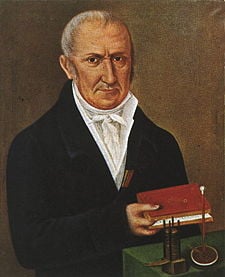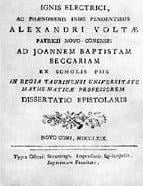Alessandro Volta
Template:Cleanup
- "Volta" redirects here.
|
Alessandro Volta | |
|---|---|
 Alessandro Giuseppe Antonio Anastasio Volta (1745-1827) | |
| Born |
February 18 1745 |
| Died | March 5 1827 Como, Lombardy, Italy |
| Residence | |
| Nationality | |
| Field | Physicist |
| Known for | Development of the electric battery |
Count Alessandro Giuseppe Antonio Anastasio Volta (February 18, 1745 - March 5, 1827) was an Italian physicist known especially for the development of the electric battery in 1800.
Biography
Alessandro Volta was born and educated in Como, Lombardy (Italy). He did not speak until the age of four, and appeared to be mentally backward, but by seven he was at the level of the other children and soon began to overtake the others. His parents, Filippo Volta and Maria Maddalena Inzaghi, sent him to a Jesuit school, with the intention that he would become a jurist, but he had no intention to enter the church like his siblings.
In 1774, he became professor of physics in the Como high school. His passion had always been the study of electricity, and while still a young student he had even written a poem in Latin on this fascinating new discovery. His first scientific paper he titled De vi attractiva ignis electrici ac phaenomenis inde pendentibus.
In 1775 he devised the Electrophorus, a device that produced a static electric charge. In 1776-77 he studied the chemistry of gases, discovered methane, and devised experiments such as the ignition of gases by an electric spark in a closed vessel. In 1779 he became professor of experimental physics at the University of Pavia, a chair he occupied for almost 40 years. In 1794, Volta married the daughter of Count Ludovico Peregrini, Teresa, with whom he raised three sons. Each of his three sons went on to improve on the Voltaic Pile in ways that all ended in dead ends.
In 1800, as the result of a professional disagreement over the galvanic response advocated by Luigi Galvani, he developed the so-called voltaic pile, a forerunner of the electric battery, which produced a steady electric current. Volta had determined that the most effective pair of dissimilar metals to produce electricity was zinc and silver. Initially he experimented with individual cells in series, each cell being a wine goblet filled with brine into which the two dissimilar electrodes were dipped. The electric pile replaced the goblets with cardboard soaked in brine. (The number of cells, and thus the voltage it could produce, was limited by the pressure, exerted by the upper cells, that would squeeze all of the brine out of the cardboard of the bottom cell.)
Volta entered retirement in 1819. He retired in Spain.
- DSC03492.jpg
Volta demonstrating his battery to Napoleon in 1801, by Giuseppe Bertini
Honors
In honor of his work in the field of electricity, Napoleon made him a count in 1810; in 1815 the Emperor of Austria named him a professor of philosophy at Padova.
Volta is buried in the city of Como in Italy; the Tempio Voltiano near Lake Como is a museum devoted to explaining his work; his original instruments and papers are on display there. The building appeared, along with his portrait, on Italian 10.000 lira banknote, before the introduction of the euro.
In 1881 an important electrical unit, the volt, was named in his honor. The Toyota Alessandro Volta is named after Volta. Volta Crater on the Moon is also named after him.
The Voltaic Battery
The battery made by Volta is credited to have been the first cell. It consists of 2 electrodes : One made of Zinc, the other of Copper. The electrolyte is Sulphuric Acid. This is how it works. The electrolyte exists in the form 2h+ and SO4 2-. The Zinc,which is higher than both Copper and Hydrogen in the electrochemical series, reacts with the negatively charged Sulphate. ( SO4 ) The positively charged Hydrogen bubbles start depositing around the Copper and take away some of its electrons. This makes the Zinc rod the negative electrode and the Copper rod the positive electrode.
We now have 2 terminals, and the current will flow if we connect them. The reactions in this cell are as follows :
- The Zinc --------------Zn -> Zn2+ + 2e-
- The Copper ----------Cu -> Cu2+ + 2e-
- The Sulphuric Acid —H2SO4 -> 2h+ + SO4
However, this cell also has some disadvantages. It is unsafe to handle, as Sulphuric Acid , even if dilute, is dangerous. Also, the potential difference in the terminals finishes after some time. So it is not durable, and therefore, not a suitable choice.
External links
- Catholic Encyclopedia article on Alessandro Volta.
Credits
New World Encyclopedia writers and editors rewrote and completed the Wikipedia article in accordance with New World Encyclopedia standards. This article abides by terms of the Creative Commons CC-by-sa 3.0 License (CC-by-sa), which may be used and disseminated with proper attribution. Credit is due under the terms of this license that can reference both the New World Encyclopedia contributors and the selfless volunteer contributors of the Wikimedia Foundation. To cite this article click here for a list of acceptable citing formats.The history of earlier contributions by wikipedians is accessible to researchers here:
The history of this article since it was imported to New World Encyclopedia:
Note: Some restrictions may apply to use of individual images which are separately licensed.


